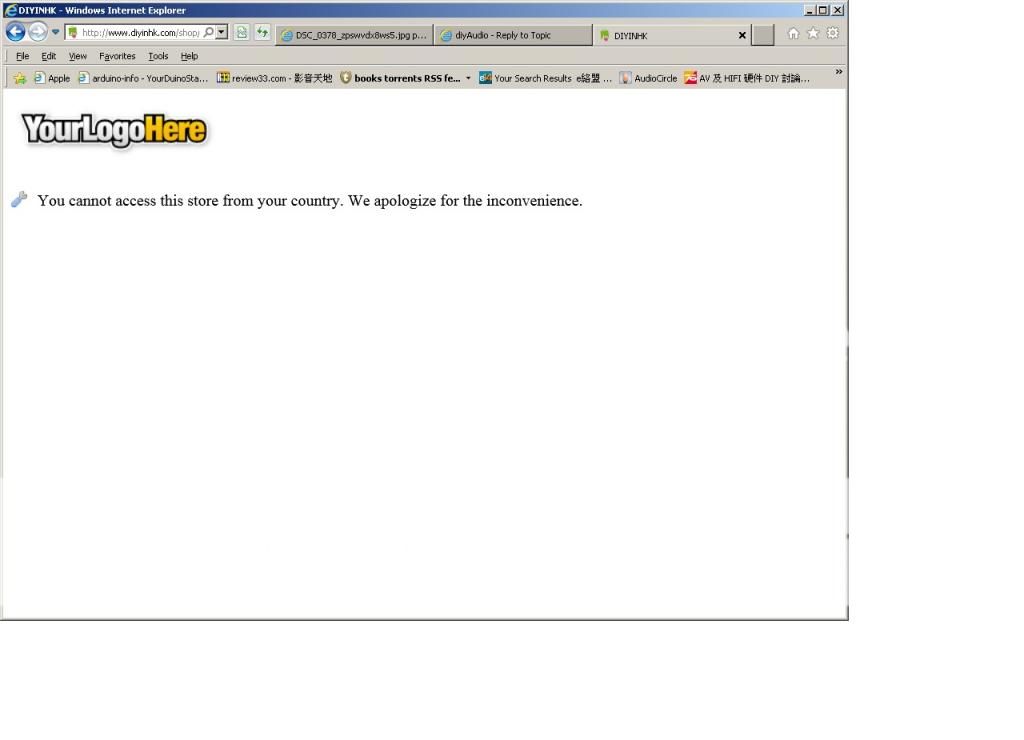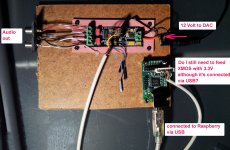SDF, fortunately I will have a big help from a good friend that is much more experienced than I am. I just need some guidance with regards to the BOM needed.
Sent from my Oneplus One
Sent from my Oneplus One
I think you get a good hardware but the AVcc regulator for DAC is too bad and need replace.
The spidf receiver integrated to the chip need to have (in stand-alone) a jitter-free source.
The spidf receiver integrated to the chip need to have (in stand-alone) a jitter-free source.
Just a word in case you feel like adding an external controller such as an Arduino later.
The bundled Xmos usb interface controls the digital volume in the DAC through the I2C bus (it uses the s/w volume control in your computer). If you wish to use an external controller for volume contro (such as using an Arduino), then you will have to purchase an Xmos interface that does not use the I2C bus such as this:
XMOS DSD DXD 384kHz high-quality USB to I2S/DSD PCB - DIYINHK
The bundled Xmos usb interface controls the digital volume in the DAC through the I2C bus (it uses the s/w volume control in your computer). If you wish to use an external controller for volume contro (such as using an Arduino), then you will have to purchase an Xmos interface that does not use the I2C bus such as this:
XMOS DSD DXD 384kHz high-quality USB to I2S/DSD PCB - DIYINHK
Thanks glt, I am planning to use this DAC with Linux and I am not interested at all in Volume control. I have it disabled in mpd confuguration file.
Sent from my Oneplus One
Sent from my Oneplus One
For beginning you can start with list you posted.
Later you can try to start with modification....
Later you can try to start with modification....
Thanks misak!
I am a little bit confused with the xmos power supply.
Please can you confirm that I don't need additional power supply for this?
Sent from my Oneplus One
I am a little bit confused with the xmos power supply.
Please can you confirm that I don't need additional power supply for this?
Sent from my Oneplus One
If you want use Xmos module alone, than you need some power supply.
If you will use it together with DAC, Xmos is taking voltage from DAC board
over connector CN1 - look here
http://www.diyinhk.com/shop/216-thickbox_default/xmos-dsd-dxd-384khz-high-quality-usb-to-i2s-pcb.jpg
and on the photo of DAC boards you can see the two 3,3V inputs (one for Xmos, second for DAC chip)
http://www.diyinhk.com/shop/250-thi...lume-control-and-spdif-inputxmoses9018k2m.jpg
and you have in your list this dual power supply
4.17uV Ultralow noise DAC power supply regulator 3.3V/5V 1Ax2 - DIYINHK
so you only need to set both to 3,3V and connect it to DAC board
only thing missing in your list are this power cables
XH Cable 25cm AWG22 - DIYINHK
(2x black-orange for 3,3V and 1x yelow-black-blue for +- 12V)
If you will use it together with DAC, Xmos is taking voltage from DAC board
over connector CN1 - look here
http://www.diyinhk.com/shop/216-thickbox_default/xmos-dsd-dxd-384khz-high-quality-usb-to-i2s-pcb.jpg
and on the photo of DAC boards you can see the two 3,3V inputs (one for Xmos, second for DAC chip)
http://www.diyinhk.com/shop/250-thi...lume-control-and-spdif-inputxmoses9018k2m.jpg
and you have in your list this dual power supply
4.17uV Ultralow noise DAC power supply regulator 3.3V/5V 1Ax2 - DIYINHK
so you only need to set both to 3,3V and connect it to DAC board
only thing missing in your list are this power cables
XH Cable 25cm AWG22 - DIYINHK
(2x black-orange for 3,3V and 1x yelow-black-blue for +- 12V)
Thank you very much Misac!
I have added many XH cables in the order I am about to place to use them in this project and have some spares too.
With regards to the transformer, I saw a link in the beginning of this thread for an rcore from eBay. I am about to order toroids from a local manufacturer here in Greece and your advice is highly appreciated.
I was told that I need 2 transformers. One 2x15 or 2x18 and one 2x9. Is it correct?
Sent from my Oneplus One
I have added many XH cables in the order I am about to place to use them in this project and have some spares too.
With regards to the transformer, I saw a link in the beginning of this thread for an rcore from eBay. I am about to order toroids from a local manufacturer here in Greece and your advice is highly appreciated.
I was told that I need 2 transformers. One 2x15 or 2x18 and one 2x9. Is it correct?
Sent from my Oneplus One
Chip used in regulator (TPS7A4700) has very low dropout (307mV at 1A according to Datasheet) so for 3,3V output a prefer 2x5V transformer. Higher voltage differnce (input vs output) = higher heat
Just a word in case you feel like adding an external controller such as an Arduino later.
The bundled Xmos usb interface controls the digital volume in the DAC through the I2C bus (it uses the s/w volume control in your computer). If you wish to use an external controller for volume contro (such as using an Arduino), then you will have to purchase an Xmos interface that does not use the I2C bus such as this:
XMOS DSD DXD 384kHz high-quality USB to I2S/DSD PCB - DIYINHK
Hi GLT,
Are you able to access the DIYINHK web site lately? I have been having problem accessing it from HK for more than a month. All I got is this message
"You cannot access this store from your country. We apologize for the inconvenience.".
Hi GLT,
Are you able to access the DIYINHK web site lately? I have been having problem accessing it from HK for more than a month. All I got is this message
"You cannot access this store from your country. We apologize for the inconvenience.".
No problem from here (USA).
Hi,
got this board recently. Made it work with Raspberry+Volumio through i2s. i2s leads must be very short (5 cm), Hifiberry must be selected in Volumio and resample set to 24/96 or 24/192. Works ok, sound is very nice. Continuing to make this board work with spdif from my HTPC motherboard. After that I am going to use the dif. outputs to feed the Brooskie Cathode Follower
got this board recently. Made it work with Raspberry+Volumio through i2s. i2s leads must be very short (5 cm), Hifiberry must be selected in Volumio and resample set to 24/96 or 24/192. Works ok, sound is very nice. Continuing to make this board work with spdif from my HTPC motherboard. After that I am going to use the dif. outputs to feed the Brooskie Cathode Follower
Are there some measurements of this DAC?
I can provide mine which are not very representative... although they could say something about this DAC.
I have neither DIYINHK XMOS module nor DIYINHK power supplies, but I've used BBB as I2S source and some shunt regulated power supply for 3.3V.
I've used parts provided in the DAC kit, the opamp is NE5532 type.
http://i.imgur.com/XlELWbd.png
The dBV axis is calibrated. For some measurements the auxiliary amplifier with +40dB gain has been used. The sound card used for measurements shows also aliases of frequencies in MHz range.
I can provide mine which are not very representative... although they could say something about this DAC.
I have neither DIYINHK XMOS module nor DIYINHK power supplies, but I've used BBB as I2S source and some shunt regulated power supply for 3.3V.
I've used parts provided in the DAC kit, the opamp is NE5532 type.
http://i.imgur.com/XlELWbd.png
The dBV axis is calibrated. For some measurements the auxiliary amplifier with +40dB gain has been used. The sound card used for measurements shows also aliases of frequencies in MHz range.
Here is a whole set of my measurements of this DAC.
DIYINHK ES9018K2M DAC measurements - Imgur
Three different opams were used: NE5532, LM4562 and OPA627
Summary of measured distortions:
- THD is bellow 0.004% (i.e. 88dB under the signal)
- THD+N is bellow 0.008% (i.e. 82dB under the signal)
(measurement setup)
Power supply for +/-12V opamp uses Capacitance Multiplier. The 3.3V supplies for DAC were two Trident V1.1 from TPA powered by 7805 regulator.
Source of I2S was BeagleBone Black with onboard clock. Sampling frequency of the test signal was 48kHz.
Recorded on ESI Juli@ sound card at 48kHz sampling frequency. For low signal measurements the signal was amplified by auxiliary +40dB gain amplifier that uses AD797 opamp.
DIYINHK ES9018K2M DAC measurements - Imgur
Three different opams were used: NE5532, LM4562 and OPA627
Summary of measured distortions:
- THD is bellow 0.004% (i.e. 88dB under the signal)
- THD+N is bellow 0.008% (i.e. 82dB under the signal)
(measurement setup)
Power supply for +/-12V opamp uses Capacitance Multiplier. The 3.3V supplies for DAC were two Trident V1.1 from TPA powered by 7805 regulator.
Source of I2S was BeagleBone Black with onboard clock. Sampling frequency of the test signal was 48kHz.
Recorded on ESI Juli@ sound card at 48kHz sampling frequency. For low signal measurements the signal was amplified by auxiliary +40dB gain amplifier that uses AD797 opamp.
Hallo,
I also dared to build a RasPI + XMOS + DAC combination, without much luck though😕
First of all, thank you very much for the instructions in the former posts. So far I figured out how the parts are connected together.
Thank you for your support
I also dared to build a RasPI + XMOS + DAC combination, without much luck though😕
First of all, thank you very much for the instructions in the former posts. So far I figured out how the parts are connected together.
- I’ve bought a DIYINHK XMOS USB DSD DXD 384k and a sellarzaudio DAC-24192-ULN,
- connected both via I2S and fed this combo to RasPi via USB. Hope this was right.
- fed the DAC with 12 V and
- I assumed that XMOS will be fed via USB but nothing happens when I power everything on.
Thank you for your support
Attachments
After a major problem I am a happy owner of this dac:
After the first 15-20 days of using this dac, the dac board died. DIYINHK acted immediately and replaced the board without any charge so now I am using the second version of my assembly.
I have changed the opamp and now I am using OPA2134. I can't say that the difference from the stock opamp is big but it's definately better to my ears.
The last step now is to put it on a nice enclosure I ordered from Italy.
I have not tested many dacs but this one was a major improvement comparing to my beloved weiliang AK4399 (however it's still one of my favourites).
An externally hosted image should be here but it was not working when we last tested it.
After the first 15-20 days of using this dac, the dac board died. DIYINHK acted immediately and replaced the board without any charge so now I am using the second version of my assembly.
I have changed the opamp and now I am using OPA2134. I can't say that the difference from the stock opamp is big but it's definately better to my ears.
The last step now is to put it on a nice enclosure I ordered from Italy.
I have not tested many dacs but this one was a major improvement comparing to my beloved weiliang AK4399 (however it's still one of my favourites).
- Home
- Vendor's Bazaar
- diyinhk Store

